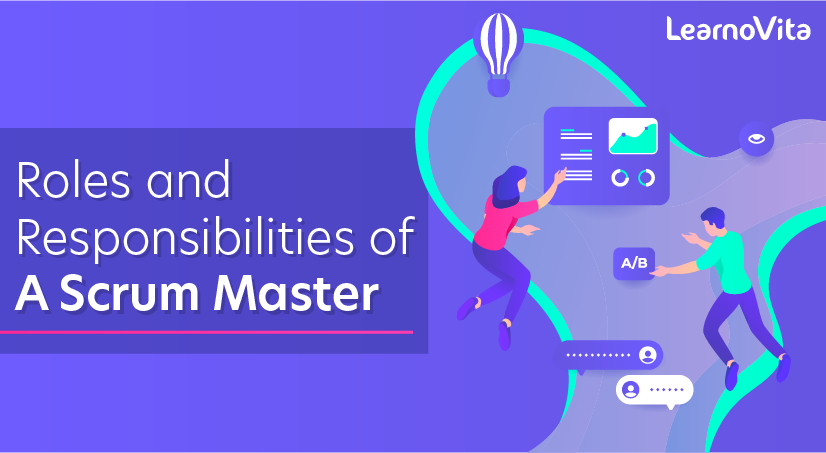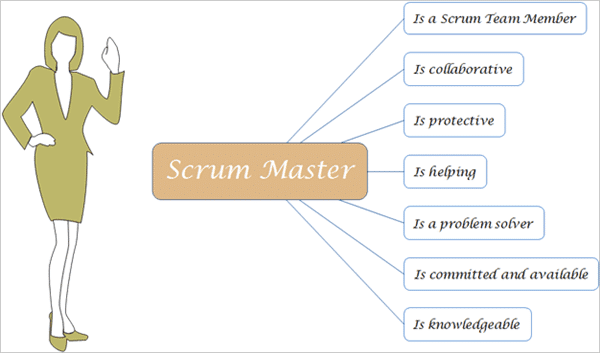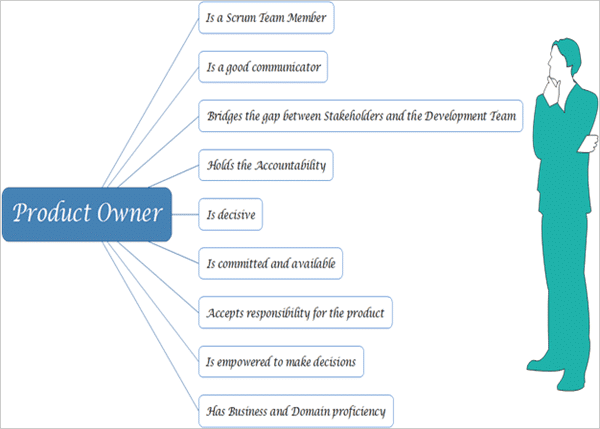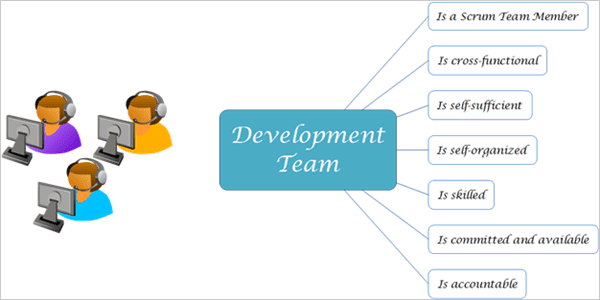
Roles and Responsibilities of A Scrum Master
Last updated on 14th Oct 2020, Artciles, Blog
Who is the Scrum Master?
- In one of our previous blog posts, Rumesh Wijetunge shared some relevant insights on the role of Scrum Master. Wearing different hats, coach, enabler, facilitator, team leader, problem-solver, s/he is in charge of giving right directions to team members so that they reach objectives.
- First promoter of Agile mindset, values and principles, the Scrum Master uses the Scrum framework to help a team in understanding, working on, and achieving a common goal.
Responsibilities of the Certified Scrum Master
It is expected from the Certified Scrum Master to promote an Agile way of working and to lead Scrum implementation in order to improve the team’s overall performance. It implies these activities:
- Teaching Agile values and principles and ensuring they have been understood and adopted by the Scrum Team, and even by the whole organization if possible (and relevant)
- Implementing the Scrum framework so that it fits the needs expressed by the Scrum Team
- Listening, observing and reflecting on how the Scrum Team is reacting to first changes, then selecting and adapting Scrum elements accordingly.
- Protecting Team Members from any interference or troubles that make them losing focus on their primary work
- Anticipating, identifying and removing any impediments, and coaching Team Members to learn to solve these situations by themselves
- Helping the Product Owner to manage the Product Backlog so that time-to-market is reduced and every increment brings value to end customers
- Acting as a Servant Leader
Subscribe For Free Demo
Error: Contact form not found.
Requirements to become a Certified Scrum Master
- Getting some basic knowledge about the Scrum framework is a nice-to-have prerequisite. However, the first mandatory step is to attend a two-day CSM course conducted by a Certified Scrum Trainer (CST)
- This course will prepare you well for the CSM exam by delivering insights about how to organize and support a Scrum Team.
- The final step is easy: you need to accept the License Agreement and update your Scrum Alliance membership profile.
Key Factors to Consider When Evaluating Scrum Master Certifications
- Employers often favor particular certifications. Understanding the reasons behind these preferences will help you sail through the screening processes when applying for a Scrum Master role.
- We asked a couple of experienced professionals for their advice.
- Linda Cook, Scrum Master for a Blue Cross and Blue Shield regional office, obtained her PMI-ACP (Project Management Institute-Agile Certified Practitioner) certification from a PMI program offered through her employer.
- The training she received is more intense than other available programs, and the in-depth certification test can take up to three hours to complete, but the credibility associated with PMI makes this type of certification desired by employers.
- Cook recommends pursuing the PMI-ACP certification after you already have a couple years of Scrum experience.
- Cook also has a CSPO (Certified Scrum Product Owner) certification from Scrum Alliance. CSPO is one of the certifications that industry experts recommend to professionals who have just started the process of building a list of Scrum-related certifications.
- People researching entry-level Scrum Master certifications often have questions about whether they should pursue CSM or CSPO certifications or both.
- “Really, they relate to different roles,” Cook said. The Scrum Master role involves the technical side of projects, while the product owner role involves the business side.
- For example, Cook is part of a team that includes six to seven IT software development professionals, one product owner and one Scrum Master.
- At the regional office where she works, there may be as many as 20 of these teams, all working on different projects.
- Plan to obtain your initial certification and subsequent certifications from credible organizations that offer quality training.
- The organizations mentioned earlier are well-respected, and offer a level of training that is worth far more than a mere certification test. That level of training will carry more weight with potential employers.
- Robert Key, senior technical project manager for BlueHornet and senior associate faculty for the University of Phoenix, agreed and recommended reviewing which organizations and certifications have solid track records and are already well-known in the technology industry.
- Key has several certifications from Scrum Alliance and PMI, including CSM, CSPO and PMI-ACP, as well as Certified Scrum Professional (CSP) and Project Management Professional (PMP).
- In addition to choosing certifications associated with credible organizations, Cook and Key offered the following points to consider:
- Show your commitment to continuous learning: Companies will notice you are committed to continuous learning when you take the initiative to obtain Scrum and Agile-related certifications. This level of motivation is a personality trait that companies like to see in Scrum Masters.
- Help strengthen team continuity: Comprehensive training and PMI-ACP certification tests establish a level of continuity among team members.
- Target the companies you want to work for and find a way to meet with a Scrum Master or IT team member from each company. The information you discover from these sources will help you decide what type of training and certifications to pursue.
- Plus, you’ll be strengthening your networking skills, which is another effective way to land a desired position at a specific company.
- Be selective and stay current: Make sure your certifications demonstrate that you are strategically building your knowledge base in certain areas rather than simply collecting acronyms.
- You don’t want to portray yourself as someone that doesn’t have the focus needed to specialize in specific areas.
Comparison of Scrum Master Certifications From Well-Known Organizations
- As you continue to evaluate certifications and the organizations issuing them, keep in mind what stage you are at within your career.
- For entry-level positions that require an appropriate foundation based on Agile and Scrum, many experts usually recommend either the CSM or CSPO certification from Scrum Alliance or the Professional Scrum Master I (PSM I) certification from Scrum.org.
- Typically these are the most recommended because they are the types of certifications many human resource representatives and hiring managers expect.
- Here is a comparative summary of the top certifications and courses for Scrum Masters, along with details about pricing, tests, and training options.
Top Personal Skills for a Scrum Master
When it comes to being scrum master which means servant leader (managing the work with no authority), there are certain skills which come handy to be successful in the role.
Here are some of the top skills of Scrum Master:
1. Scrum master is responsible to facilitating daily scrum, sprint planning, sprint demo and retrospective meetings.
2. Possesses conflict resolution, does conversation by focusing on scrum values of openness, honesty and respect.
3. Should be a friendly communicative person, because when team is moving fast in Agile, communication is the effective force which holds the team together.
4. Needs to forecast the numbers of deliverables possible in an iteration, which is based on evidence and reliable source.
5. Needs to be expert in estimation and planning. He knows how to create useful, reliable and practical plans for software development projects.
6. Should be a good coach in Agile practices. S/he can coach individuals and interactions over processes and tools.
7.Help team or individual to clarify goals and actions to achieve them.
8. Ability to shield his team from outside distractions and interferences.
9. Ability to ensure the correct use of scrum process.
10. Ability to track and remove impediments.
11. Scrum master is a servant first, who serves his team members before considering about himself
Duties of Scrum Master
- Facilitate his team for better creativity and tries to improve the efficiency of the development team.
- Responsible for managing the scrum process with the coordination of scrum team in Agile methodology.
- Responsible to remove the impediments for the scrum team.
- Arranged daily stand-up meetings, facilitate meetings, schedule meetings, demo and decision-making processes in order to ensure quick inspection and proper use of adaptation process.
- Helps product owner to make the product backlogs in good shape and make them ready for the next sprint.
- Responsible to Conduct retrospective meetings.
- Organizes and facilitates the sprint planning meeting.
- Acts as safeguard for his team.
Technical Skills:
- Knowledge of agile methodology and frameworks like Scrum, Kanban, XP, etc.
- Good skills to coach team how to follow agile scrum, which really works.
- Understand the basic fundamentals of iterative and incremental development.
- Strong knowledge of Scrum theory, rules and practices.
- Knowledge of other Agile approaches, like: Kanban, Crystal, FDD, XP, etc.
- Knowledge about other methodologies other than Agile-Scrum, so that he can explain other methodologies to motivate his team.
- Basic knowledge of software development processes and procedures to understand his team needs.
- He should have knowledge about Agile techniques like: User Stories, Continuous Integration, ATDD, TDD, Continuous Testing, Pairing, Automated Testing, Agile Games.
- Ability to take and understand his commitment to deliver the product on time.
- Know about the value of metrics and incremental delivery.
- Knowledge about tasks, backlog tracking, burndown metrics, velocity, user stories etc.
- Familiar with common development practices, Service oriented environments, and Agile practices.
Roles and Responsibilities
1) Coach – The Scrum Master acts as an Agile Coach for both the Development team and the Product Owner. The Scrum Master in a way acts as an enabler for proper communication between the Development Team and the Product Owner. The Scrum Master stays responsible to eliminate the obstacle between both the other roles.
If it is noticed that the Product Owner is not getting involved or not giving proper time to the Development Team, then it is the Scrum Master’s job to coach the Product Owner regarding the importance of his involvement to the overall team’s success.
2) Facilitator – The Scrum Master also acts as a facilitator for the Scrum Team. He facilitates and organizes all the Scrum Events requested by the Scrum Team Members. The Scrum Master also facilitates the Team in making important decisions that would increase the productivity of the Scrum Team as a whole.
The Scrum Master never orders the Team Members to do something rather, he helps them in achieving it by coaching and guiding.
3) Removing Impediments – The Scrum Master is also responsible for removing the impediments that impact the team’s productivity in delivering business. Any impediment that the team members cannot resolve on their own comes to the Scrum Master for resolution.
The Scrum Master prioritizes these impediments based on their impact on the team’s productivity and business and starts working on them.
4) Interference Gatekeeper – The Scrum Master also safeguards the Scrum Team from outside interference and distraction so that the team can remain focused on delivering the best value to the business after every sprint.
The interference can be of a greater concern if the team is working in a Scaled Scrum environment where multiple Scrum Team is working together and have the dependencies amongst them.
The Scrum Master makes sure that the team stays out of any irrelevant discussion and focuses on the Sprint items whereas he himself takes the responsibility of addressing the queries and concerns coming from outside.
Scrum Master is responsible to protect the team from outside interference and for removing the impediments in order to let the team focus on delivering the business value.
5) Servant Leader – The Scrum Master is often referred to as a Servant Leader of the Scrum Team. One of his most important responsibilities is to ask the Scrum Teams for their concerns and to make sure that they are addressed.
It is the duty of the Scrum Master to confirm that the essential requirements of the team are prioritized and met to let them work effectively and produce high performing results.
6) Process Improver – The Scrum Master along with the team is also responsible for regularly improvising the processes and practices employed to maximize the value being delivered. It is not the Scrum Master’s responsibility to get the work done but it is his responsibility to enable the team to devise a process that would let them complete their sprint goals.

The Product Owner
Another very crucial role that we are going to discuss in this tutorial is the Product Owner. Product Owner is the voice of the customer /stakeholders and hence is responsible for bridging the gap between the development team and stakeholders. Product owner manages the gap in such a way which would maximize the value of the product being built.
Product Owner is set to be involved throughout the Sprint Activities and Development efforts and plays a very crucial role in the success of a product.
Roles and Responsibilities
1) Bridging the Gap – Product Owner works closely with the internal and external stakeholders to gather the inputs and synthesize a vision to place the product features in the Product Backlog.
It is the Product Owner’s responsibility to understand the requirements and preferences of the stakeholder/customer community as he is the one who is acting as their representative and shoulders the responsibility of building the right solution.
At the same time, the Product Owner ensures that the Development Team understands what needs to be built and when. He collaborates with the team on a daily basis. Product Owner’s engagement with the Team increases the feedback frequency and response time which as a result boosts the value of the product being built.
Absence/Less Collaboration of a Product Owner can lead to disastrous results and ultimately Scrum failure.
Product Owner ensures that the Product Backlog items are transparent & clearly expressed and everyone in the team holds the same understanding of the item.
2) Manages Product Backlog – As an outcome to the above point, the Product Owner is responsible for the creating and managing the Product Backlog, ordering the items in the Product Backlog to best achieve the Stakeholder’s requirements i.e. prioritization of Product Backlog items and finally he should always be available to answer or give clarification to all the Development Team’s queries.
Overall, he is responsible to groom the Product Backlog in order to improve the delivered value.
Anyone who wants to add/remove an item in the Product Backlog or needs to change the priority of an item should be directed to the Product owner
3) Certifying a Product – His another responsibility is to certify the features being built. In this process, he defines the Acceptance Criteria for each of the Product Backlog Item. The Product Owner might also create the Acceptance Tests representing the Acceptance Criteria defined by him or might take an assistance from the SMEs or the Development Team in creating them.
Now, he is the one who ensures that the Acceptance Criteria are met by executing the Acceptance Tests. He may choose to execute these Acceptance Tests on his own or can ask the experts to do so to ensure that the functional and quality aspects are fulfilled and expectations are met.
This activity is usually done throughout the sprint as and when the items are completed so that the mistakes could be uncovered and can be fixed before the actual Sprint Review Meeting.
4) Participation – Product Owner is a key participant in the Sprint related activities. He works closely with the Development Team in explaining the Items, their scope and the value it holds.
He also acts as an enabler for the Development Team to be able to pick up the Product Backlog items that they are supposed to deliver by the end of the Sprint. Besides Sprint activities, Product Owner also works on the Product Release activities.
During the Product release activities, the Product Owner engages with the Stakeholders to discuss the items of the next release. One of the key success factors for a team to flourish is that the entire team should respect the Product Owner and his decisions. No one other than the Product Owner should tell the team what items to work on.
It is recommended to have a single full-time product owner for a single product. However, there can be an arrangement where the product owner is a part time role.
Proxy Product Owner
Proxy Product Owner is a person enrolled by the Product Owner himself who can take over all his responsibilities, his absence and support him. Proxy Product Owner is liable and accountable for all the responsibilities that he has been delegated to but the responsibility of the work being done eventually still lies with the actual Product Owner.
The Proxy Product Owner is also empowered to make the necessary decisions on behalf of the actual Product Owner.

The Development Team
Another very important part of the Scrum Team is the Development Team. The Development Team is comprised of developers proficient in their own area of expertise. Unlike the other Scrum Team members, the Development Teamwork on the actual implementation of the potentially deliverable software/increment which is to be delivered at the end of each Sprint.
The Development Team may consist of people having specialized skills like Front-end Developers, Backend Developers, Dev-Ops, QA Experts, Business Analyst, DBA etc., but they are all referred to as Developers; No other titles are allowed. The Development Team cannot even have sub-teams within it like the testing team, requirement specification team etc.
The Team is set up considering all the essential skill set required to successfully develop, test & deliver the product increments every Sprint without the outside help. Thus, the team is expected to be self-sufficient and cross-functional. The Development Team doesn’t take any help from outside the Scrum Team and manages their own work.
The accountability of developing Increments always lies with the Development Team as a whole but everyone in the Scrum Team is responsible for the overall delivery.
It is solely the Development Team’s decision to add/remove a Team Member. If a new skill set is required, the Development Team can choose to build that expertise within the team or add a new member to the team.
Roles and Responsibilities
1) Development and Delivery – The Development Team is responsible for creating a done increment based on the ‘Definition of Done’ at the end of each sprint. The done Increment may not necessarily be a part of the next production release but it is definitely a potentially releasable functionality that an end user can use.
It is the Product Owner’s call to decide what needs to be part of the release. The Development Team though is accountable for developing and delivering the Done Increment every Sprint that meets the criteria under Definition of Done.
2) Tasking and Providing Estimations – The Development Team is also responsible for picking up the User Stories/Items from the prioritized Product Backlog to be delivered in the next Sprint. Thus, these Items then constitute a Sprint Backlog. Sprint Backlog is created during a Sprint Planning meeting.
Another very important responsibility that a Development Team does is to create tasks by breaking down the Sprint Items and providing estimates to these Sprint Items.
Nobody tells the Development Team what and how to do things. It is the Development Team’s responsibility to pick up the items from the Product Backlog that can be delivered in the next Sprint. Once the Sprint is started, the items cannot be changed/added/removed.
Development Team Size
Development Team size should be chosen wisely as it can directly hamper the productivity of the team thereby impacting the product delivery. The Development Team should not be very large as it might require a lot of coordination amongst the team members.
However, for a very small team, it would be very difficult to have all the skills required to deliver an Increment. Thus, an optimal number should be chosen for the Development Team Size.
The recommended Development Team size is from 3 to 9 members excluding the Scrum Master and Product Owner unless they are also developing the Software Increment along with the other developers.

Conclusion:
The Scrum Master acts as the protector of the team, making sure that everyone is on the right track, and the project is up and running. Scrum master plays a pivotal role in balancing the interests of the other two scrum-roles: the product owner and the development team. To balance these two different forces, the Scrum Master should be cooperative and supportive. Usually, the Scrum Master doesn’t stand between the product owner and the team, rather he/she helps in developing a clear communication and results in timely and high-quality project deliveries.
Are you looking training with Right Jobs?
Contact Us- What Is a ScrumMaster?
- Roadmap to CSM (Certified Scrum Master) Certification
- Agile Scrum Master Interview Questions and Answers
- How to build a successful Career in Agile and Scrum?
- Agile Scrum Tutorial
Related Articles
Popular Courses
- PMP Certification Training
11025 Learners - MS Project Training
12022 Learners - Microsoft Excel Training
11141 Learners
- What is Dimension Reduction? | Know the techniques
- Difference between Data Lake vs Data Warehouse: A Complete Guide For Beginners with Best Practices
- What is Dimension Reduction? | Know the techniques
- What does the Yield keyword do and How to use Yield in python ? [ OverView ]
- Agile Sprint Planning | Everything You Need to Know


